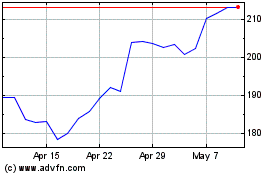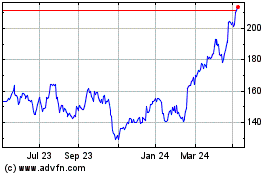Banks Have Had Enough of Oil's Wild Ride
August 25 2016 - 2:50PM
Dow Jones News
By Rachel Louise Ensign
When oil fell below $30 a barrel earlier this year, banks turned
away from lending to energy companies. The price of crude has
bounced back nearly 80% from its February low, but banks are still
wary.
Big banks cut loans to the energy sector by about 3% in the
second quarter over all and some individual lenders pulled back
much more, according to an analysis of July and August securities
filings by Barclays analysts.
Oil's continued volatility isn't helping. Oil prices rose by
around 26% in the second quarter, only to fall nearly 14% in July.
This month, prices have so far bounced back by more than 12%.
Moreover, there is increased regulatory scrutiny of energy-sector
lending and exposures at banks.
Houston-based Green Bancorp, with about $4 billion of assets, is
among those that has pulled back. Chief Executive Geoff Greenwade
said this month that energy lending is "7% of our loan portfolio,"
but that, "It takes about 80% of our time." The bank earlier this
year decided it didn't want this headache and said it would divest
its current energy portfolio and halt future lending.
Despite oil prices being on firmer ground of late, energy loans
remain the most troubled part of banks' portfolios. And lenders
have socked away billions to cover potential losses.
At large U.S. banks including J.P. Morgan Chase & Co., Wells
Fargo & Co. and Bank of America Corp., a median 42% of energy
loans were considered criticized in the second quarter, Barclays
said. This means they are at higher risk of default. While few
energy loans are actually going bad -- a median 1.5% were charged
off in the second quarter -- large banks have collectively set
aside $6.4 billion in reserves for energy loan losses.
Lenders are getting rid of energy borrowers in a variety of
ways. Some are cutting the amount of credit they are willing to
extend. Others, like CIT Group Inc. and Green Bancorp, are also
selling some loans off entirely.
Banks with particularly big declines in energy loans included
U.S. Bancorp and Comerica Inc.; each trimmed energy exposure by
around 11% in the second quarter.
Murphy Oil Corp. is one example of how this has been playing
out. When the company in August renewed its $2 billion credit line,
eight of the 18 banks who took part in the current revolver --
including U.S. Bank and Comerica -- didn't sign on for a new loan
that extends through 2019, according to recent securities
filings.
In the end, the Arkansas exploration-and-production company got
$1.2 billion under the new line of credit, while the other banks
remained lenders under the older loan that expires next June. The
banks that continued lending to the company -- including J.P.
Morgan, Bank of America and Wells Fargo -- lent Murphy less than
they had under the previous credit agreement.
A Murphy spokeswoman declined to comment on whether the company
would have taken out a larger revolver if those lenders had signed
on.
Bankers and their advisers say a tougher regulatory stance is
playing a role: The Office of the Comptroller of the Currency in
March published an updated manual for energy lending. While the OCC
said in a statement that the "handbook imposes no new restrictions
on oil an gas lending," banks say this has effectively established
stricter guidelines for such loans.
Banks have said the new manual has led them to classify more
exploration-and-production borrowers as higher risk, or criticized.
Using one key measure in the handbook, 91% of a sample of
independent exploration and production companies would merit a
criticized rating in 2016, according to an analysis of such
companies' financials by law-firm Haynes and Boone LLP.
Over all, large banks cut loans to exploration and production
companies about 8% in the second quarter, Barclays said.
Not all firms are retreating. Some banks are boosting energy
lending as others hang back. J.P. Morgan Chase & Co, for
instance, increased energy loans by 3% in the second quarter. The
bank's trading desk has also bought some revolver debt of
distressed energy borrowers from smaller banks for between 85 and
90 cents on the dollar since the second quarter, a person familiar
with the matter said.
Emily Glazer contributed to this article.
Write to Rachel Louise Ensign at rachel.ensign@wsj.com
(END) Dow Jones Newswires
August 25, 2016 14:35 ET (18:35 GMT)
Copyright (c) 2016 Dow Jones & Company, Inc.
Barclays (LSE:BARC)
Historical Stock Chart
From Mar 2024 to Apr 2024

Barclays (LSE:BARC)
Historical Stock Chart
From Apr 2023 to Apr 2024
